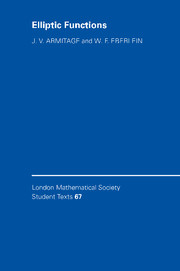This is essentially a prolegomenon to the Partial Preface and serves primarily to place in a proper context the contents of this book and how they relate to the original six chapters, to which it refers.
Those six chapters, originally by W. F. Eberlein, sought to relate the ideas of Abel to the later work of Jacobi and concluded with the transformation theory of the theta functions. The first chapter began with the differential equation associated with the motion of a simple pendulum, very much in the tradition of Greenhill's ‘Applications of Elliptic Functions’ (1892), but much influenced by the spirit of modern analysis. (Greenhill's obituary reads that ‘his walls (were) festooned with every variety of pendulum, simple or compound.’) The version given here is inspired by those early chapters and, apart from the addition of illustrative examples and extra exercises, is essentially unchanged.
The present account offers six additional chapters, namely 7 to 12, together with an Appendix, which seek to preserve the essentials and the spirit of the original six, insofar as that is possible, and which include an account of the Weierstrass functions and of the theory of elliptic integrals in Chapters 7 and 8. There follows an account of applications in (mainly classical) geometry (Chapter 9); in algebra and arithmetic – the solution of the quintic in Chapter 10, and sums of three squares, with references to the theory of partitions and other arithmetical applications in Chapter 11); and finally, in classical dynamics and physics, in numerical analysis and statistics and another arithmetic application (Chapter 12).
